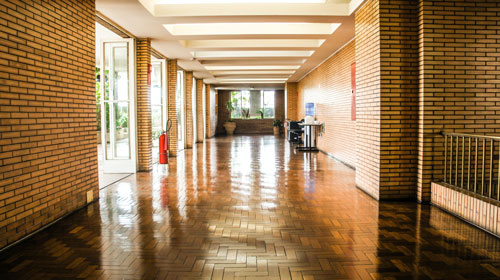According to the U.S. Department of Labor, slips, trips, and falls make up the majority of general industry accidents, which account for:
- 15% of all accidental deaths per year, the second-leading cause behind motor vehicles
- About 25% of all reported injury claims per fiscal year
- More than 95 million lost work days per year — about 65% of all work days lost
In general, slips and trips occur due to a loss of traction between the shoe and the walking surface or an inadvertent contact with a fixed or moveable object which may lead to a fall. There are a variety of situations that may cause slips, trips and falls including:
- Wet or greasy floors
- Dry floors with wood dust or powder
- Uneven walking surfaces
- Polished or freshly waxed floors
- Loose flooring, carpeting or mats
- Damaged or irregular steps; no handrails
- Shoes with wet, muddy, greasy or oily soles
- Clutter, electrical cords or cables
- Ramps and gang planks without skid-resistant surfaces
- Weather hazards — rain, sleet, ice, snow, hail, frost
Prevent slips, trips and falls by using 6 basic steps for creating a safer work environment:
1. Create Good Housekeeping Practices
Proper housekeeping is a routine. It is an ongoing procedure that is simply done as a part of each worker’s daily performance.
Plan ahead – Know what needs to be done, who’s going to do it and what the particular work area should look like when you are done.
Clean as you go – Housekeeping is everyone’s responsibility. Take time throughout the day to pick up and remove debris from the work area.
Take a few minutes at the end of each shift to clean the work area.
2. Reduce Wet or Slippery Surfaces
Outdoor walking surfaces can impact indoor walking surfaces:
- Keep parking lots and sidewalks clean and in good repair condition.
- When snow and ice are present, remove or treat these elements.
- Use adhesive striping material or anti-skid paint whenever possible.
Indoor control measures:
- Use moisture-absorbent mats with beveled edges in entrance areas.
- Use “Wet Floor” signs as needed.
- Use anti-skid adhesive tape in troublesome areas.
- Clean up spills immediately.
- Use slip resistant mats in designated areas
3. Avoid Creating Obstacles in Aisles and Walkways
Injuries can result from trips caused by obstacles and clutter in aisles, entranceways, stairwells and at the bottom of ladders.
Keep all work areas, passageways, storerooms and service areas clean and orderly.
Avoid stringing cords, cables or air hoses across hallways or in any designated aisle.
In office areas, avoid leaving boxes, files or briefcases in the aisles.
Encourage safe work practices, such as closing file cabinet drawers after use and picking up loose items from the floor.
Conduct periodic inspections for slip and trip hazards.
4. Create and Maintain Proper Lighting
Poor lighting in the workplace is associated with an increase in accidents.
Keep work areas and aisles well-lit and clean.
Upon entering a darkened room, always turn on the light first.
Keep poorly lit walkways clear of clutter and obstructions.
Keep areas around light switches clear and accessible.
Repair fixtures, switches and cords immediately if they malfunction.
5. Wear Proper Shoes
The shoes we wear can play a big part in preventing falls and are a critical component of PPE. Shoelaces need to be tied correctly. Employees are expected to wear footwear appropriate for the duties of their work task.
6. Control Individual Behavior
It’s human nature to let our guard down temporarily and be distracted by random thoughts or doing multiple activities. Being in a hurry will result in walking too fast or running, which increases the chances of a slip, trip or fall. Taking shortcuts, not watching where one is going, using a cell phone, carrying materials which obstruct the vision, wearing sunglasses in low-light areas, not using designated walkways and speed are common factors in many on-the-job injuries.
It’s ultimately up to each individual to plan, stay alert and pay attention.
